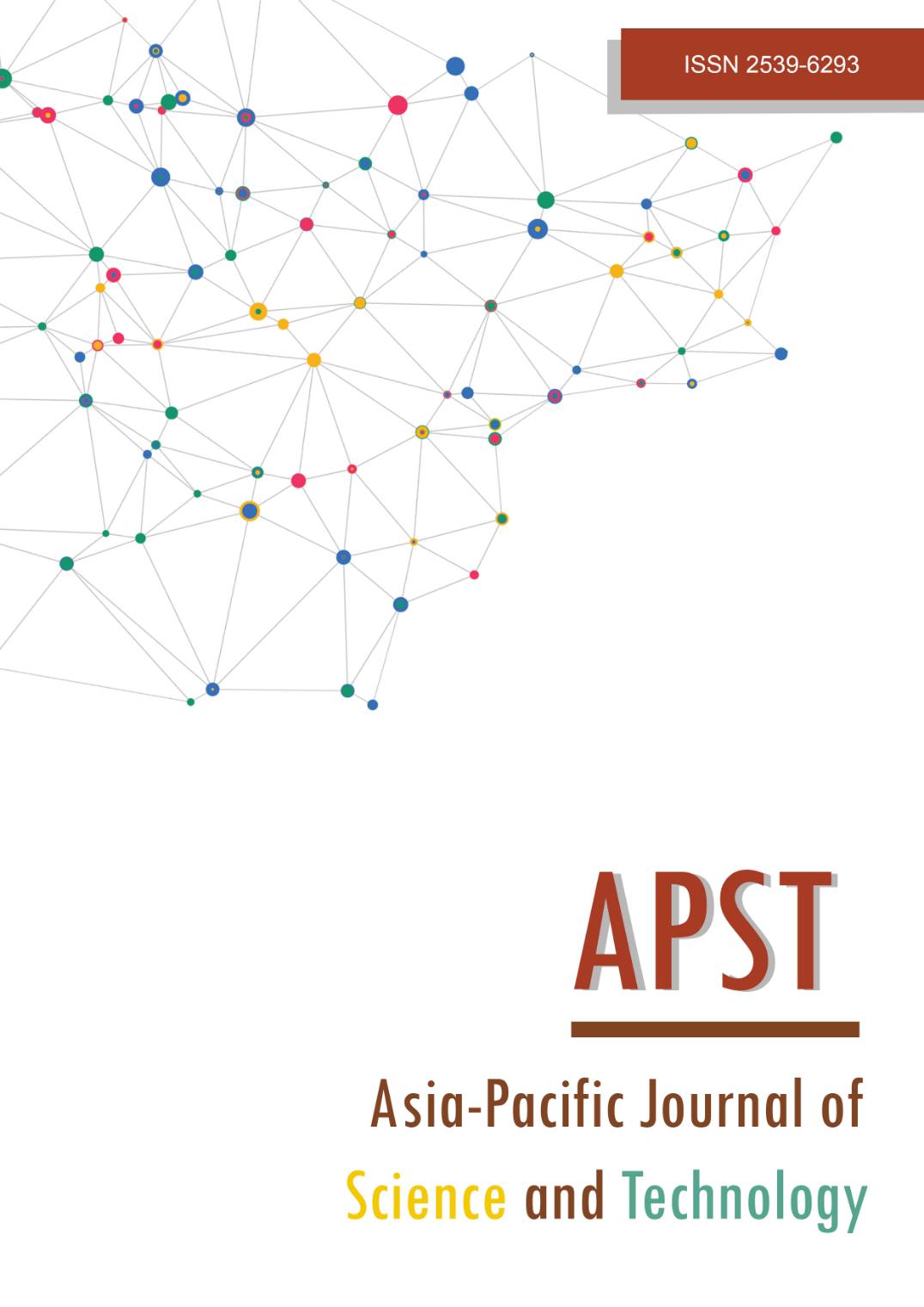Ethanol and beta-glucan production from an economically feasible medium prepared from paper napkin hydrolysate
Main Article Content
Abstract
At present, the zero-waste concept is a major concern and a challenging topic. Among several renewable materials that contain high cellulose content, napkin papers are potential sources of ethanol production and other value-added products. This work aimed to study the feasibility of an economic medium formulation from napkin hydrolysate for ethanol production and subsequent beta-glucan extraction from the spent yeasts. The medium costs per gram of ethanol produced from napkins and 3 different nitrogen sources, i.e., yeast malt extract (YM), urea, and ammonium sulfate, were compared. The results revealed that the new medium formulation from napkin-ammonium sulfate is economical at 18% ethanol production over commercial YM medium. Furthermore, the remaining yeast cells from the fermentation process were autolyzed, and beta-glucan was extracted prior to Fourier transform infrared (FTIR) spectroscopy for compositional and structural analyses. The FTIR integration peaks indicated that the S. cerevisiae TISTR 5339 cell wall contained beta-1,3-glucan as the main polysaccharide component. Overall, this study was successful in developing a practical, economical medium for the biotransformation of napkins to ethanol and producing value-added beta-glucan from the spent yeast from the ethanol production process; these products can potentially be used in the pharmaceutical or food industries in the future.
Article Details
References
[2] Sundvor I, López-Aparicio S. Impact of bioethanol fuel implementation in transport based on modelled acetaldehyde concentration in the urban environment. Sci Total Environ. 2014;496:100-6.
[3] Manzetti S, Andersen O. A review of emission products from bioethanol and its blends with gasoline. Background for new guidelines for emission control. Fuel. 2015;140:293-301.
[4] Reed G, Nagodawithana TW. Yeast-Derived Products. In: Reed G, Nagodawithana TW, editors. Yeast Technology. Dordrecht: Springer; 1991. p. 369-412.
[5] Jones AM, Thomas KC, Ingledew WM. Ethanolic fermentation of blackstrap molasses and sugar cane juice using very high gravity technology. J Agric Food Chem. 1994;42(5):1242-6.
[6] Li Z, Wang D, Shi YC. Effects of nitrogen source on ethanol production in very high gravity fermentation of corn starch. J Taiwan Inst Chem Eng. 2017;70:229-35.
[7] Techaparin A, Thanonkeo P, Klanrit P. High-temperature ethanol production using thermotolerant yeast newly isolated from Greater Mekong Subregion. Braz J Microbiol. 2017;48:461-75.
[8] Nuanpeng S, Thanonkeo S, Yamada M, Thanonkeo P. Ethanol production from sweet sorghum juice at high temperatures using a newly isolated thermotolerant yeast Saccharomyces cerevisiae DBKKU Y-53. Energies. 2016;9(4):253.
[9] Danbamrongtrakool N, Tungcharoen T, Parakulsuksatid P. Effect of urea on ethanol production by Saccharomyces cerevisiae Sc90. Proceedings of 52nd Kasetsart University Annual Conference: Agro-Industry; 2014 Feb 4-7; Bangkok, Thailand. Bangkok: Kasetsart University; 2014. p. 263-70.
[10] Chen J, Seviour R. Medicinal importance of fungal β-(1→3), (1→6)-glucans. Mycol Res. 2007;111 (6):635-52.
[11] Hong F, Hansen RD, Yan J, Allendorf DJ, Baran JT, Ostroff GR, et al. Beta-Glucan functions as an adjuvant for monoclonal antibody immunotherapy by recruiting tumoricidal granulocytes as killer cells. Cancer Res. 2003;63(24):9023-31.
[12] Liu J, Gunn L, Hansen R, Yan J. Combined yeast-derived β-glucan with anti-tumor monoclonal antibody for cancer immunotherapy. Exp Mol Pathol. 2009;86(3):208-14.
[13] Laopaiboon L, Nuanpeng S, Srinophakun P, Klanrit P, Laopaiboon P. Ethanol production from sweet sorghum juice using very high gravity technology: effects of carbon and nitrogen supplementations. Bioresour Technol. 2009;100(18):4176-82.
[14] Miller GL. Use of dinitrosalicylic acid reagent for determination of reducing sugar. Anal Chem. 1959;31 (3):426-8.
[15] Wang L, Sharifzadeh M, Templer R, Murphy RJ. Technology performance and economic feasibility of bioethanol production from various waste papers. Energy Env Sci. 2012;5(2):5717-30.
[16] Pengkumsri N, Sivamaruthi BS, Sirilun S, Peerajan S, Kesika P, Chaiyasut K, et al. Extraction of beta- glucan from Saccharomyces cerevisiae: comparison of different extraction methods and in vivo assessment of immunomodulatory effect in mice. Food Sci Technol. 2017;37(1):124-30.
[17] Thin R, Techaparin A, Klanrit P, Apiraksakorn J. Determination of beta-1,3 glucan content of spent yeast by ftir spectroscopy analysis. The 31st annual meeting of the Thai Society for Biotechnology and International Conference (TSB 2019); 2019 Nov 10-12; Phuket, Thailand. Bangkok: Thai Society for Biotechnology. p. 779-86.
[18] Sockalingum GD, Bouhedja W, Pina P, Allouch P, Mandray C, Labia R, et al. ATR-FTIR spectroscopic investigation of imipenem-susceptible and -resistant Pseudomonas aeruginosa isogenic strains. Biochem Biophys Res Commun. 1997;232(1):240-6.
[19] Wiercigroch E, Szafraniec E, Czamara K, Pacia MZ, Majzner K, Kochan K, et al. Raman and infrared spectroscopy of carbohydrates: a review. Spectrochim Acta A Mol Biomol Spectrosc. 2017;185:317-35.
[20] Kuhad RC, Mehta G, Gupta R, Sharma KK. Fed batch enzymatic saccharification of newspaper cellulosics improves the sugar content in the hydrolysates and eventually the ethanol fermentation by Saccharomyces cerevisiae. Biomass Bioenergy. 2010;34(8):1189-94.
[21] Marques S, Alves L, Roseiro JC, Gírio FM. Conversion of recycled paper sludge to ethanol by SHF and SSF using Pichia stipitis. Biomass Bioenergy. 2008;32(5):400-6.
[22] Nissen TL, Kielland-Brandt MC, Nielsen J, Villadsen J. Optimization of ethanol production in Saccharomyces cerevisiae by metabolic engineering of the ammonium assimilation. Metab Eng. 2000;2(1):69-77.
[23] Kasavi C, Finore I, Lama L, Nicolaus B, Oliver SG, Toksoy Oner E, et al. Evaluation of industrial Saccharomyces cerevisiae strains for ethanol production from biomass. Biomass Bioenergy. 2012; 45:230-8.
[24] Kwiatkowski JR, McAloon AJ, Taylor F, Johnston DB. Modeling the process and costs of fuel ethanol production by the corn dry-grind process. Ind Crops Prod. 2006;23(3):288-96.
[25] Galichet A, Sockalingum GD, Belarbi A, Manfait M. FTIR spectroscopic analysis of Saccharomyces cerevisiae cell walls: study of an anomalous strain exhibiting a pink-colored cell phenotype. FEMS Microbiol Lett. 2001;197(2):179-86.
[26] Jaehrig SC, Rohn S, Kroh LW, Wildenauer FX, Lisdat F, Fleischer LG, et al. Antioxidative activity of (1-3), (1-6)-beta-d-glucan from Saccharomyces cerevisiae grown on different media. LWT - Food Sci Technol. 2008;41(5):868-77.


